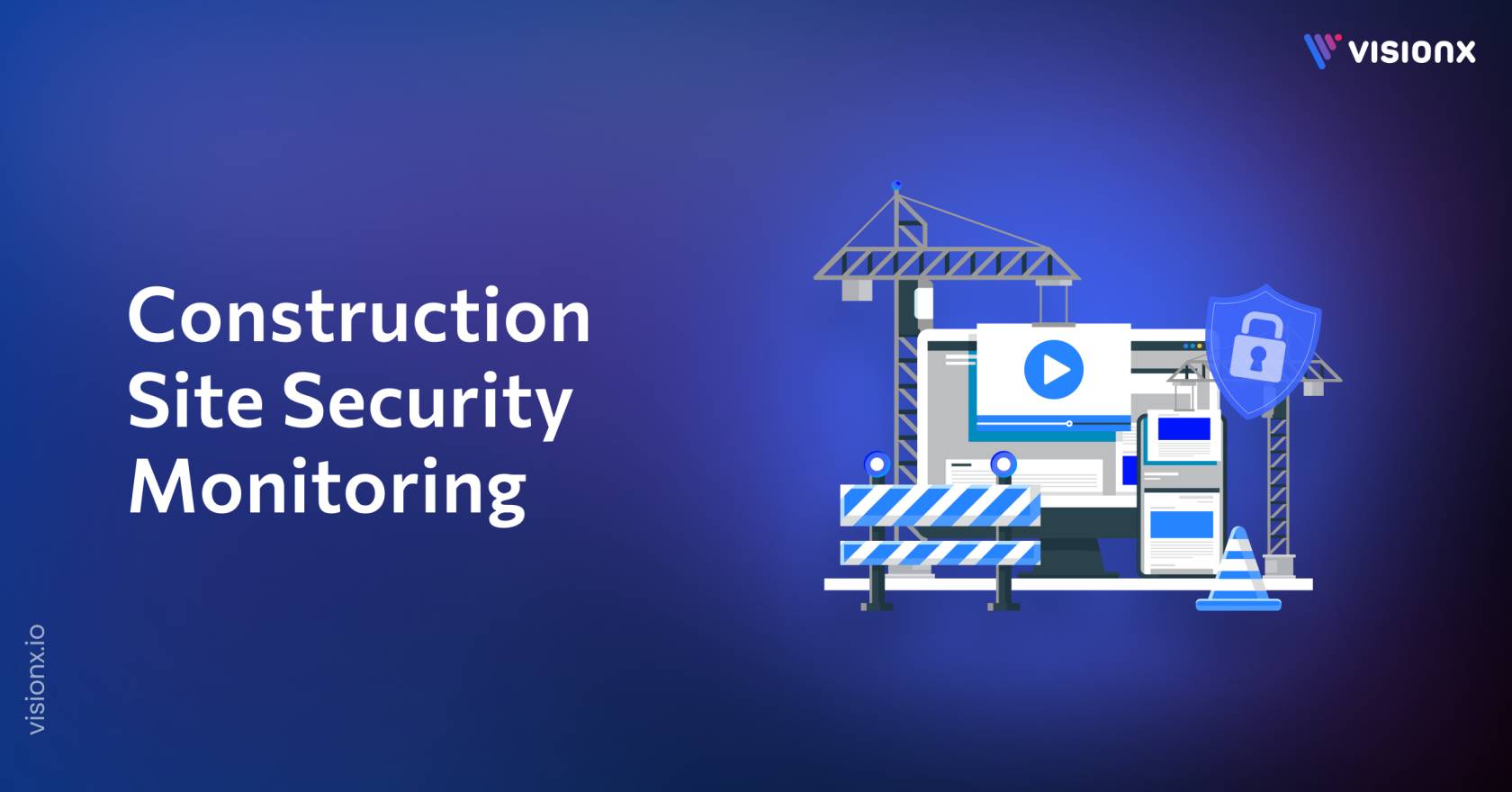Construction sites are prime targets. With millions of dollars in tools, materials, and equipment on-site, one weak point can open the door to major losses. In fact, theft and vandalism cost the construction industry over $1 billion each year in the U.S., according to recent statistics.
Strong construction site security is more than a locked gate. It’s a smart, layered defense that works in real time. When you invest in security, you are not just guarding materials, but you are guarding your entire project.
In this guide, I’ll walk you through the most effective types of construction site security systems and show you how to choose the one that fits your site. By the end, you’ll know exactly what to use to keep intruders out and your peace of mind intact.
What Is Construction Site Security Monitoring?
Construction site security monitoring means keeping a constant watch over your site to detect and respond to threats, vandalism, and safety hazards through multiple tools and technologies. It uses a mix of hardware and software that includes surveillance systems, access control measures, and even live remote monitoring to prevent theft, stop criminal activity, and make sure workers stay safe.
As more jobs are happening in remote locations and tighter project deadlines, construction site security is more critical than ever. According to a report, the global construction site monitoring market will hit USD 3.488 billion by 2033. That tells you just how serious the industry is about better site protection.
Today, you have more tools than ever. You can set up live construction cameras, add motion sensors, or even use AI cameras for construction that flag suspicious activity without needing someone to watch screens all day.
10 Types of Construction Site Security Monitoring
Here are 10 types of construction site security systems to help you protect your project from theft, vandalism, and costly delays.
1. Surveillance Cameras (CCTV & IP Cameras)
Surveillance cameras help you watch your job sites 24/7. Most construction site security systems start here. For movement tracking, you can install either fixed cameras or pan-tilt-zoom (PTZ) cameras. Select cameras with night vision and high quality to capture every detail.
These days, smart features like motion alerts, AI-based person detection, and license plate recognition are common in construction site security cameras. By eliminating false warnings brought on by weather or animals, these video surveillance systems help identify actual dangers.
Example: A Boston-based builder reduced theft by 70% after installing IP-based construction site security cameras with thermal imaging.
2. Remote Video Monitoring Services
This is like having a virtual security guard on duty. Instead of watching video footage yourself, trained operators monitor feeds off-site. They verify threats and alert local law enforcement only when needed.
Remote video monitoring helps reduce false alarms and catch real issues before they escalate. According to a report, businesses that use AI-powered video surveillance reduce response time by 50%.
These services also document every incident with timestamps, snapshots, and video clips. This makes it easier to investigate and report security breaches.
3. On-Site Security Guards
Sometimes, you need eyes and boots on the ground. A physical security guard can patrol the site, respond fast, and check access points manually.
They also act as a visible deterrent, making it less likely that someone attempts to trespass. Many companies combine guards with construction site camera security for layered protection.
Although costly, guards can intervene in real time, help with crowd control, and coordinate with law enforcement when needed.
4. Access Control Systems
You should know who enters and exits your site. Access control relies on key cards, codes, or biometrics to limit entry. Access control systems include biometric scanners, smart locks, digital logs, and temporary visitors’ badges.
It also provides audit trails that show who came in, when, and for how long. This level of control helps with worker accountability and limits risk.
Combining access control with construction site security camera monitoring makes your system airtight. It gives you both eyes and records at every entry point.
5. Mobile Surveillance Units
Need fast setup? Mobile units come ready with cameras, solar panels, sirens, and speakers. These self-contained systems work well for short-term projects, pop-up sites, or remote locations with limited access to utilities.
You can place them anywhere, no need for hardwired power or internet. Most units feature built-in cellular connectivity, motion detection, and remote access through a mobile app or web dashboard.
They’re also cost-effective. You can rent them instead of investing in permanent infrastructure. This makes them ideal for construction projects with changing locations, temporary setups, or early-stage work before permanent security systems go in.
6. Alarm and Intrusion Detection Systems
Construction site security monitoring is only as strong as its weakest link, and that often starts with early detection. Alarm and intrusion detection systems help catch suspicious activity before it turns into a costly setback. They detect motion, forced entry, door access, vibration, and other signs of intrusion. When triggered, alarms notify your team or a monitoring station within seconds.
Intrusion systems rely on multiple sensor types, including infrared, magnetic, and acoustic, to detect threats in real-time. Many units also include sirens and flashing lights to alert nearby personnel and scare off intruders before they can cause harm
If you want better results, pair alarms with video surveillance. This combo gives context to alerts, helps verify threats quickly, and lowers the risk of theft, vandalism, or costly project delays.
7. Drone Surveillance
Drones give you aerial views of large or multi-phase construction projects. You can fly them on a schedule or during off-hours for inspections and patrols.
Many drones now support AI in construction safety. They detect human presence in restricted zones, monitor traffic patterns, and track large equipment in real time.
They are especially useful for jobs that cover wide areas or have multiple access points. Drones can patrol faster than humans and capture detailed footage from above.
8. Fencing and Physical Barriers
Fences do more than block entry. They guide foot traffic, define boundaries, and slow down criminals. You can add lighting and sensors to enhance security in your construction projects. When combined with locks and advanced electronic locking devices, they create a layered defense that deters intruders and restricts access to specific zones.
Barriers should be high, tamper-resistant, and clearly marked. Add smart fencing options that trigger alerts when the fence is disturbed.
Smart fencing works with your existing security systems to create alert zones. It also helps in keeping non-workers safe by restricting access to hazardous areas.
9. License Plate Recognition (LPR)
License Plate Recognition (LPR) systems scan and log every vehicle that enters your site and help boost both construction site security monitoring and site safety. Connected to access control, they allow or deny entry based on pre-approved lists.
LPR is great for construction site safety monitoring because it helps track deliveries, subcontractors, and vendors. It can also flag unauthorized or blacklisted vehicles.
The data collected can sync with time-tracking and billing systems for streamlined operations.
10. Wearables and IoT Sensors
Modern construction site safety monitoring systems now use wearables to track worker health and safety. These devices detect falls, unsafe behavior, or lack of movement.
IoT sensors can also detect noise, dust levels, and temperature, creating a safer and healthier work environment. AI cameras for construction integrate this data to flag real-time risks.
These devices are ideal for protecting construction sites where hazards change daily. They provide actionable insights without needing someone to always watch.
How to Build a Site Security System for Your Construction Project
A strong site security system starts when you know your site’s weak spots, use smart tools, and put the right people in charge.
Here’s how you can approach building a reliable security setup tailored to your construction project:
- Start with a site assessment. Walk your perimeter. Look for blind spots and entry points. Think like an intruder.
- Next, list your security goals. Are you protecting tools, equipment, people, or all three?
- Now, pick your tech. Mix live construction cameras with access control and alarms. If your job site sits in a remote location, add mobile units and remote video monitoring.
- Integrate everything. Make sure your cameras, alarms, and sensors talk to each other. A unified platform helps you see threats in one place.
- Finally, stay compliant. Many construction projects must follow UL 827 or OSHA standards. A secure site is also a safe site.
How to Choose the Best Construction Site Security System
Here’s how to select the best system for effective construction site security monitoring:
1. Evaluate Your Site’s Size, Layout & Phases
Start with a site walkthrough. How big is it? Are there multiple phases happening at once? Larger sites or multi-entry locations may need more construction site security monitoring. Tight, compact sites might do better with fewer but smarter construction AI cameras.
2. Identify Security Threats
Think about the issues you’ve seen. Is it tool theft? Trespassing? Equipment damage? Choose construction site security solutions that target your biggest problems, not just what looks good on paper.
3. Set Budget and Resource Constraints
Every dollar counts on a construction project. Focus on construction site security systems that give you long-term value. Remote video monitoring and AI-driven tools like AI cameras for construction might cost more upfront, but they save on labor and loss.
4. Look for Scalable & Integrated Solutions
Your project will change. Your construction site camera security should, too. Go for tools that plug into one platform, so you can scale without starting from scratch.
5. Ensure Legal & Insurance Compliance
Don’t skip the paperwork. Make sure your construction site security setup meets safety codes, insurance policies, and industry standards. That means things like OSHA guidelines, UL certifications, and local access rules.
Why Choose VisionX for Construction Site Security Monitoring?
VisionX gives you everything you need to protect construction sites with confidence.
We combine AI cameras for construction, smart analytics, and real-time alerts into one unified platform. That means you don’t just get alerts, you get context. You see what’s happening, when, and why.
Our systems detect suspicious activity, track people and assets, and reduce false alarms that waste your team’s time. Whether you run a single site or manage dozens of job sites, we scale with your needs.
VisionX systems plug into your existing security systems, so you can enhance what you have without starting over. And if you’re starting fresh, we help you build the right construction site security system from day one.
Don’t just watch your site. Understand it. Automate it. Secure it. With VisionX, you have clarity. You’re in control.
FAQs
Why is construction site security monitoring important?
Construction site security monitoring helps prevent theft, vandalism, and unauthorized access. It ensures worker safety, protects valuable equipment, and reduces costly project delays. Real-time surveillance also helps improve incident response and supports insurance claims with video evidence.
Do construction sites have security?
Yes, most construction sites have some level of security. This can include security guards, fencing, cameras, and construction site security systems that monitor activity around the clock.
How do you ensure security on a construction site?
You start with a risk assessment. Then, you use tools like surveillance cameras, access control systems, mobile units, and alarm systems. The best approach uses a mix of these tools with real-time monitoring.
What is site monitoring in construction?
Site monitoring involves keeping watch over your job site to detect threats, track activity, and ensure safety. This can include live construction cameras, motion sensors, remote video feeds, and AI-powered alerts.
About Author

M. Waqas Mushtaq is the Co-Founder and Managing Director of VisionX, whose passion for innovation fuels the company’s growth. Under his strategic direction, VisionX promotes a culture of excellence, solidifying its position as an industry leader.


